Frenching onions is a technique that every professional chef must learn to master. This culinary technique involves removing the outer layer and making precise cuts to transform onions into beautifully shaped garnishes that appeal visually to any dish.
It not only enhances the presentation but also elevates the taste experience of your dish. However, it can appear daunting to beginners and tricky to execute perfectly. Fortunately, you can learn to use French onions like a pro with a few tips and tricks.
Here we will guide you through the art of Frenching onions step-by-step. We will cover everything from selecting the right onion to the right tools for the job. Additionally, we’ll share some insider tips and tricks to help you achieve that perfect cut and shape.
Whether you’re an aspiring chef or a home cook looking to impress your guests, mastering the technique of Frenching onions will add a touch of elegance and sophistication to your meals.
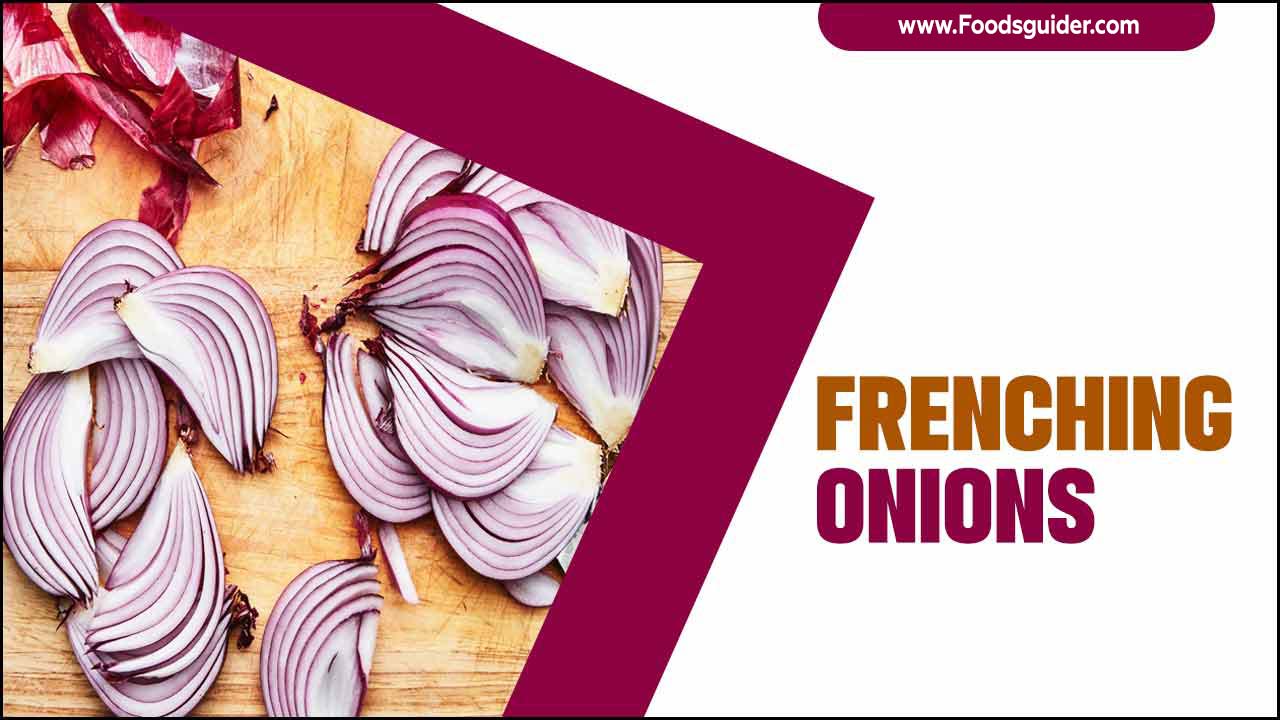
Slicing Technique For Frenching Onions
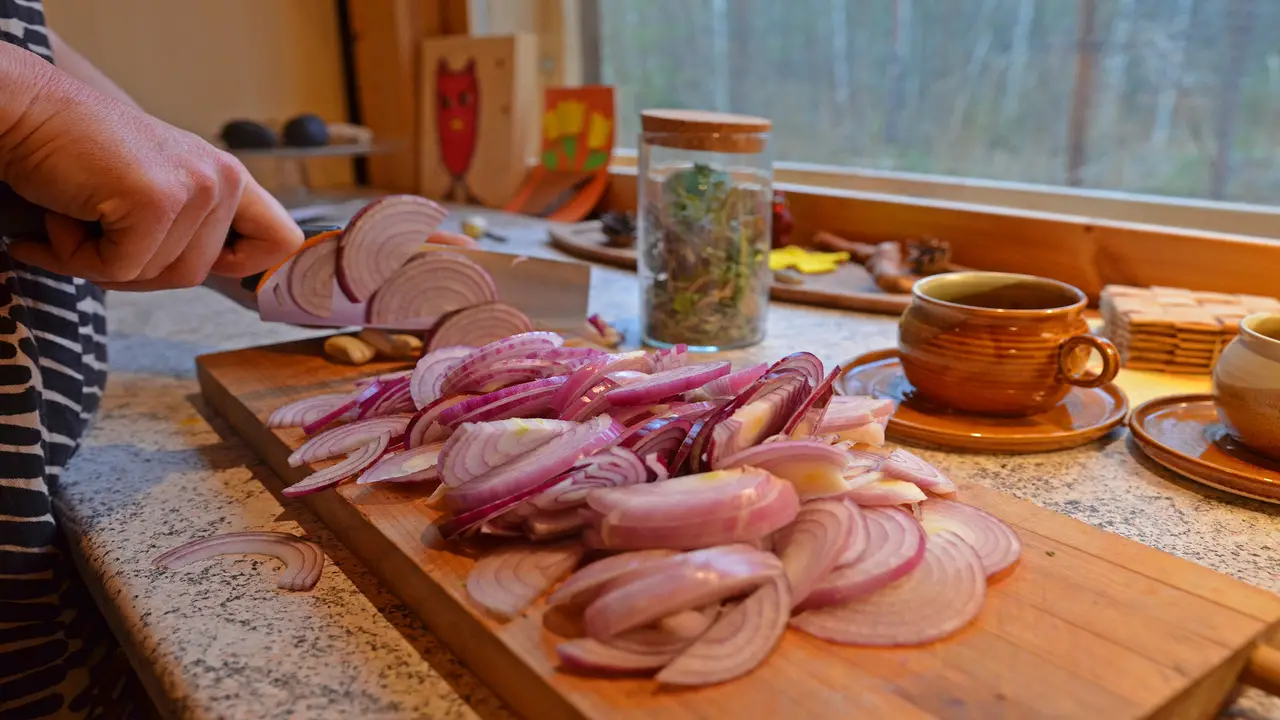
Frenching onions refers to a culinary technique that involves finely slicing an onion in a specific manner to create uniform, thin strips. First, cut off the onion’s ends and halve it lengthwise to achieve this. Then, peel off the skin and remove the outermost layer.
Make lengthwise cuts with the flat side down, leaving the root end intact to hold the layers together. Finally, slice across the cuts to produce fine strips. These “Frenching” strips are commonly used for garnishes, salads, and various dishes where a delicate texture and mild onion flavor are desired, enhancing the overall presentation and taste of the dish.
Select The Onion
Onion Frenching is a culinary technique used to prepare onions for various dishes, particularly in French cuisine. The process involves slicing the onion into thin, uniform strips, also known as julienne cuts. To achieve this, peel the onion and cut off the ends.
Then, cut the onion in half and lay it flat on the cutting board. Slice the onion lengthwise into thin strips, maintaining a consistent thickness throughout. Onion Frenching enhances the visual appeal and texture of dishes, adding a touch of elegance to salads, soups, and main courses. The thin, delicate onion strips blend seamlessly into recipes, allowing for even flavor distribution.
This technique is prevalent in dishes where a milder onion taste is desired, as the thinly sliced onions impart a subtle and pleasant flavor. Mastering this skill requires practice, but the effort is well worth it, as Frenching onions can elevate the overall taste and presentation of a wide range of culinary creations.
Prepare The Onion
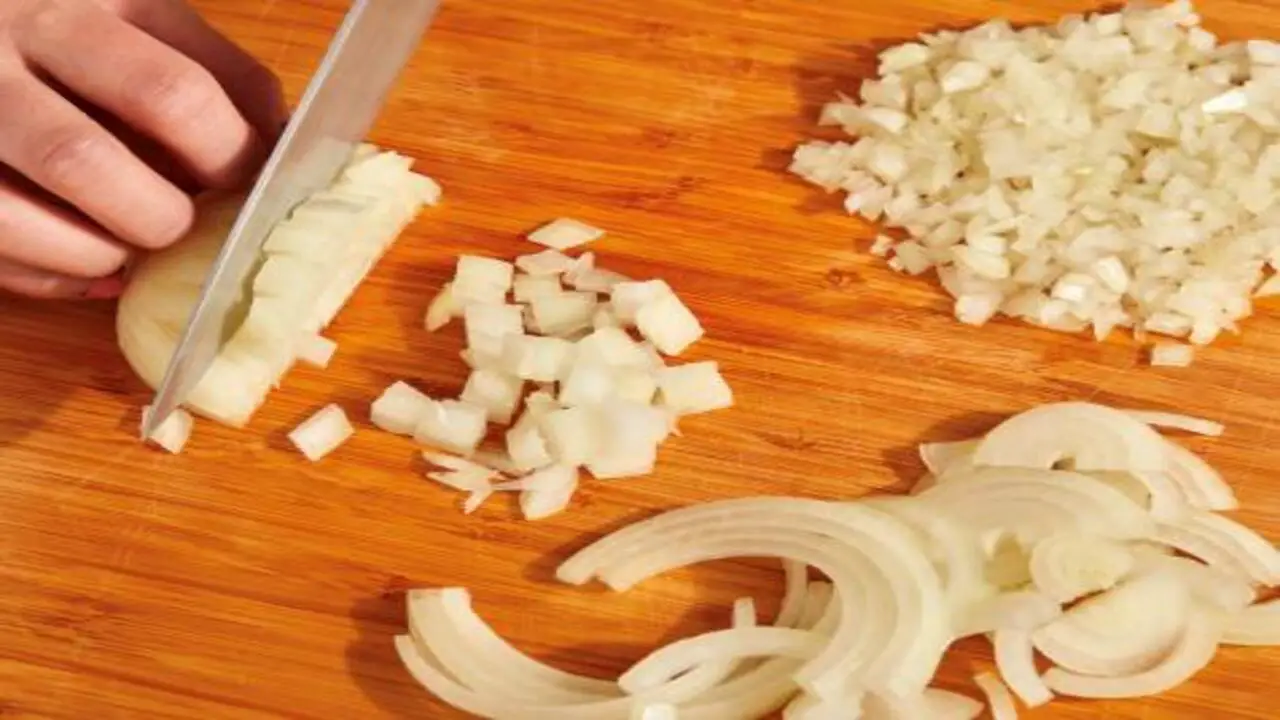
Start with a fresh onion and remove the outer papery skin. Keep the root end intact. Cut off the top of the onion, about 1/4 inch from the tip.
Using a sharp knife, make vertical cuts from the top towards the root, evenly spaced about 1/4 inch apart. Be careful not to cut all the way through the root end.
Next, make horizontal cuts across the onion, again about 1/4 inch apart. This will create a grid pattern. Finally, submerge the onion in ice water for 10-15 minutes to help the “petals” open up, resulting in a beautifully fringed appearance. Frenching onions adds an elegant touch to dishes like salads, garnishes, and roasted dishes, enhancing presentation and flavor.
Cut The Onion In Half
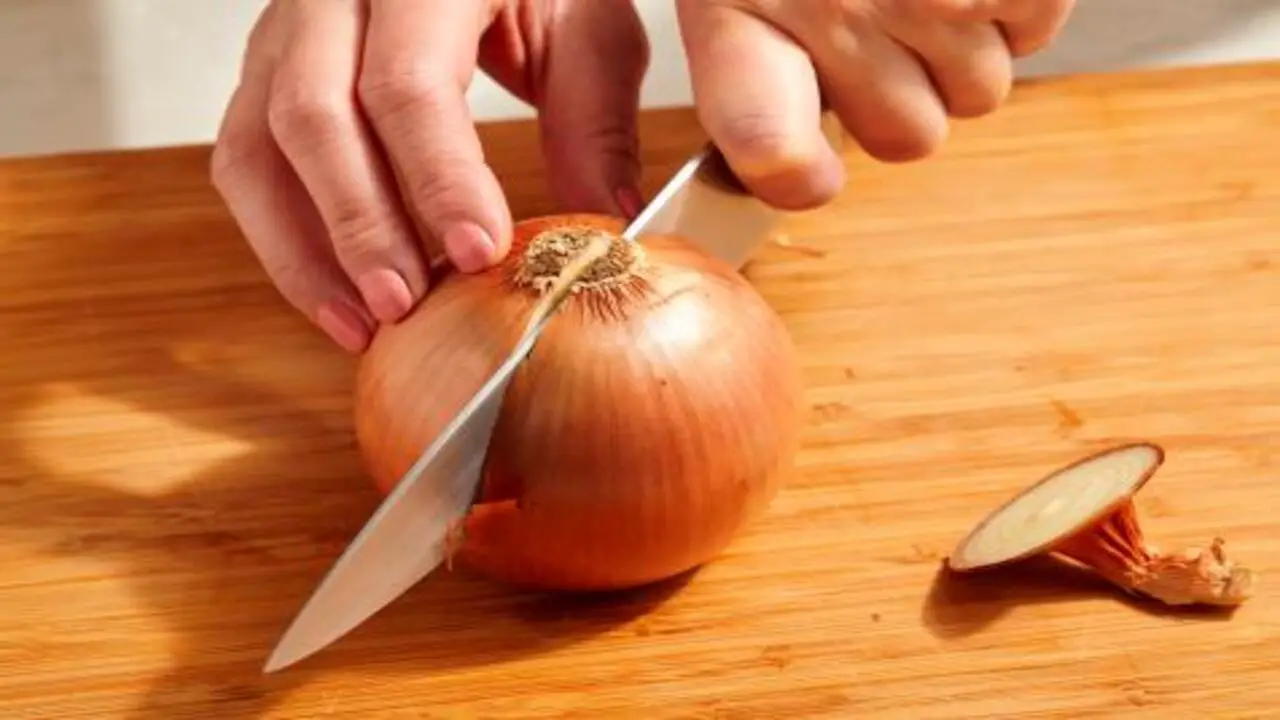
Cutting the onion in half and Frenching it is a technique used in culinary arts to create finely sliced, uniform strips from half an onion. To do this, cut the onion in half vertically, ensuring that the root end is intact to hold the layers together. Peel off the skin from both halves and place one-half flat on the cutting board.
With a sharp knife, make vertical cuts into the onion, starting from the rounded edge and moving towards the root end, but without cutting through the root. Then, again, carefully make horizontal cuts into the onion without cutting through the root end. The result is a half onion with finely sliced layers that resemble a fan or ‘fringes,’ hence the term ‘Frenching.’
Frenching onions are often used in recipes that call for a delicate flavor and a visually appealing presentation, such as garnishes, salads, or certain sautéed dishes.
Remove The Inner Core
Removing the inner core, also known as “Frenching” onions, involves removing the central portion of the onion bulb to create a more delicate and uniform appearance. To do this, cut off the onion’s top and bottom, then peel off the outer skin. Next, make a vertical incision from the top, cutting about halfway down the onion without slicing through it thoroughly.
Repeat this step several times around the onion to create evenly spaced cuts. Finally, insert the knife at a slight angle and remove the core by cutting it away from the surrounding onion. Frenching onions enhances their presentation in dishes and helps them cook more evenly. The removed core can be saved for other culinary uses or discarded.
Make Thin Vertical Cuts
Frenching onions involves making thin vertical cuts to create a decorative and visually appealing garnish. First, choose a fresh, firm onion and peel off the outer skin to achieve this. Trim off the top and bottom ends.
Slice the onion in half from top to bottom with a sharp knife. Lay one-half flat on the cutting board, cut side down. Now, start making parallel vertical cuts along the length of the onion, ensuring they are close together and uniformly thin.
Take care not to cut all the way through the root end, keeping the layers intact. Once done, repeat the process with the other half. Frenching onions adds elegance to dishes, particularly for garnishing salads, soups, or entrees, elevating the overall presentation and dining experience.
Finalize The French Onion Strips
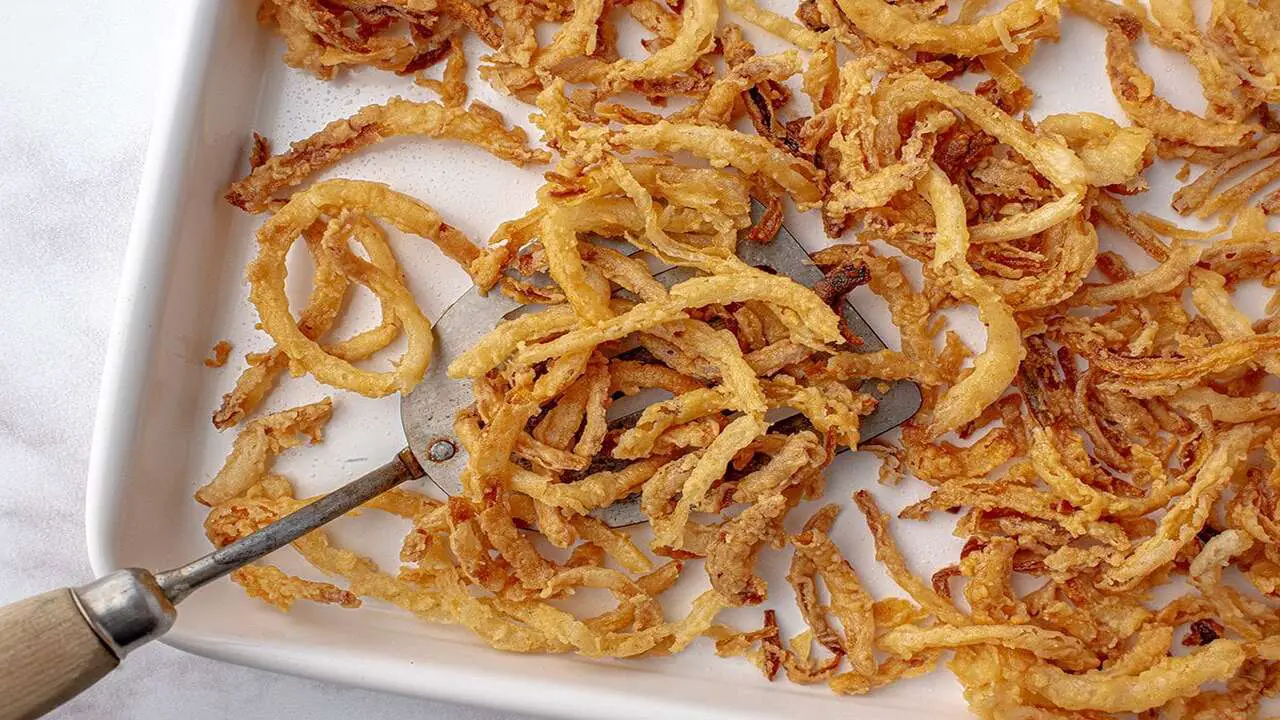
To finalize the French Onion Strips, start by “Frenching” the onions. This culinary technique involves cutting the onions into thin, even strips. Begin by peeling the onion and cutting it half from top to bottom. Place each half-flat side on the cutting board and make vertical cuts along the length, creating long, slender strips. Ensure your knife is sharp for precise cuts.
Aim for the best results for strips about 1/4 to 1/2 inch wide. Frenching the onions enhances their appearance and texture and allows for even cooking. These beautiful, uniform strips are ideal for French onion soup, salads, sandwiches, and stir-fries.
After Frenching the onions, you can sauté them with butter until they caramelize and turn golden brown, unleashing their sweet, savory flavor. This step adds depth to your dishes and transforms the ordinary onion into a culinary delight. Enjoy your French Onion Strips’ rich, aromatic essence in your favorite recipes.
Repeat With The Other Half
“Repeat with the Other Half Frenching Onions” seems unclear as it does not convey a specific context or instruction. Frenching onions” typically refers to a culinary technique where onions are cut into thin strips or slices. However, the meaning of “Repeat with the Other Half” is not apparent without more information.
If you are referring to a recipe or cooking instruction involving onions, please provide additional details or the entire context so I can give you a more accurate 150-word answer. Otherwise, if you have any other questions or topics, feel free to ask; I’ll be happy to assist.
Use As Desired
Frenching onions is a culinary technique handy to finely slice onions into thin, uniform strips. This method is often employed to enhance the appearance and texture of various dishes. First, remove the outer skin and cut off the root end to French an onion.
Then, make vertical cuts from the top to the root, creating long, slender strips. Frenching onions can elevate the presentation of salads, soups, and garnishes, adding a touch of elegance and visual appeal to the plate.
These beautifully sliced onions make dishes look more sophisticated and contribute to a balanced flavor distribution. The thin onion strips disperse their taste more evenly, enhancing the overall taste experience.
Moreover, Frenching onions are popularly handy in dishes where a delicate onion flavour is desired, as they lend a milder taste compared to regular chopped onions. Frenching onions is a versatile culinary technique that can elevate the presentation and flavor profile of various dishes.
Conclusion
You are now a master of the Frenching technique. Slicing and dicing onions is no longer a daunting task but a culinary skill you can now show off to your friends and family. With some practice, you can expertly French any onion in minutes.
You can be proud of your newfound culinary skills and use them to create delicious, flavorful dishes to impress your guests. Frenching onions is no longer a tedious task but a skill you can showcase and master.
When you French an onion, you take thin slices off it, making it look stunning and adding layers of flavor to your dishes. So go ahead, and impress your guests with perfectly sliced onions in your next dish. And who knows, you may even inspire some of them to try Frenching too.
FAQs
1.What Is Frenching An Onion, And Why Is It Important In Cooking?
Ans: Frenching an onion refers to the technique of finely slicing the onion into thin, even strips. It is essential in cooking because it ensures uniformity in the size of onion pieces, leading to even cooking and consistent flavor distribution.
2.Which Type Of Onion Is Best For Frenching?
Ans: Yellow or white onions are generally the best choices for Frenching. Their size and texture make them easier to slice into uniform strips and have a milder flavor than red onions.
3.How Do I Select A Good Onion For Frenching?
Ans: Look for onions that are firm, with dry and papery outer skins. Avoid onions with soft spots or signs of sprouting, as they may not yield the best results when Frenching.
4.What Dishes Can I Use Frenched Onions In?
Ans: Frenched onions can be a garnish for soups, salads, and sandwiches. They can also add a flavorful touch to stir-fries, fajitas, and other sautéed dishes.
5.Are There Any Other Vegetables Commonly “Frenched” In Cooking?
Ans: Besides onions, other vegetables like carrots, zucchini, and celery can also “frenche.” The technique involves slicing them into long, thin strips, similar to Frenching onions, providing a visually appealing and uniform dish presentation.